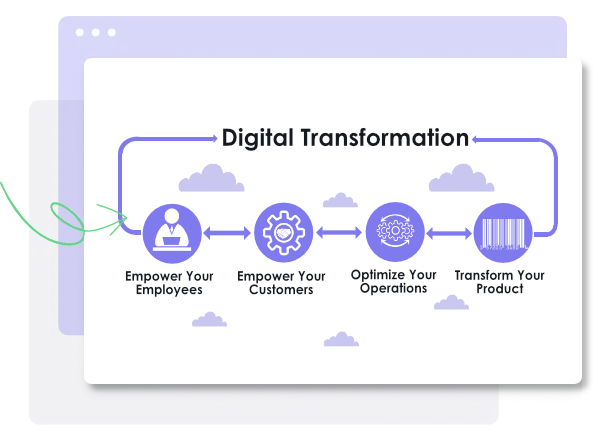Start your Digital Transformation Today
Digital transformation is a term that describes the process of using digital technologies to create new or modify existing business processes, culture, and customer experiences to meet changing business and market requirements. It is a way of reimagining business in the digital age, driven by customer expectations and fueled by technology. It is not a one-time fix, but a continual adaptation to a constantly changing environment. It is not only about adopting new tools and platforms, but also about changing mindsets, behaviors, and capabilities.
It is not only about improving efficiency and productivity, but also about creating value and innovation.
Digital transformation can have different meanings and implications for different industries, sectors, and organizations. However, some common elements and benefits of digital transformation are:
- Customer-centricity: Digital transformation enables organizations to understand their customers better, anticipate their needs and preferences, deliver personalized and seamless experiences across channels and devices, and build trust and loyalty.
- Data-driven decision making: Digital transformation allows organizations to collect, analyze, and leverage data from various sources, such as transactions, interactions, sensors, social media, etc., to generate insights, optimize processes, predict outcomes, and drive actions.
- Agile and flexible operations: Digital transformation empowers organizations to adapt quickly and effectively to changing market conditions, customer demands, and competitive pressures, by enabling faster and smarter workflows, automation, collaboration, scalability, and resilience.
- Innovation and differentiation: Digital transformation fosters a culture of experimentation, learning, and creativity, by enabling new ways of thinking, solving problems, creating value propositions, developing products and services, and engaging with customers.
Digital transformation is not a linear or uniform process. It can involve different stages, dimensions, levels, and speeds of change. Some frameworks and models that can help understand and guide digital transformation are:
- maturity model: This model assesses the degree of digital adoption and integration in an organization across four stages: basic (using digital technologies for specific functions or processes), intermediate (using digital technologies for cross-functional or cross-departmental processes), advanced (using digital technologies for end-to-end or enterprise-wide processes), and transformative (using digital technologies for creating new business models or markets).
- transformation framework: This framework identifies six key elements or domains of digital transformation: strategy (the vision, goals, and roadmap for digital transformation), leadership (the roles, skills, and culture that enable digital transformation), customer (the understanding, engagement, and satisfaction of customers in the digital age), technology (the selection, implementation, and integration of digital technologies), operations (the optimization.
Digital transformation can have different meanings and implications for different industries, sectors, and organizations. However, some common elements and benefits of digital transformation are:
- Cost reduction: Digital transformation can help organizations cut costs by improving asset efficiency, supporting worker productivity, reducing overhead and production costs, and streamlining after-market service. For example, by using cloud computing, organizations can save on hardware, software, and maintenance costs, as well as scale up or down as needed. By using automation, organizations can eliminate manual errors, optimize processes, and free up human resources for more value-added tasks.
- Quality improvement: Digital transformation can help organizations improve quality by enabling closed-loop quality management, where data and feedback are used to monitor, measure, and improve quality throughout the value chain. For example, by using sensors and IoT devices, organizations can track product performance, detect defects, and prevent failures. By using AI and machine learning, organizations can analyze customer feedback, identify patterns, and provide personalized recommendations.
- Customer satisfaction and loyalty: Digital transformation can help organizations increase customer satisfaction and loyalty by delivering personalized and seamless experiences across channels and devices . For example, by using CRM systems, organizations can collect and manage customer data, segment customers based on their behavior and preferences, and tailor marketing campaigns accordingly. By using chatbots and virtual assistants, organizations can provide 24/7 customer support, answer queries, and resolve issues.
- Data-driven decision making: Digital transformation can help organizations enhance data-driven decision making by collecting
Our consulting experts can give you the advice that you require so you can plan appropriately, implement wisely, and deploy successfully.
